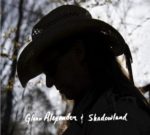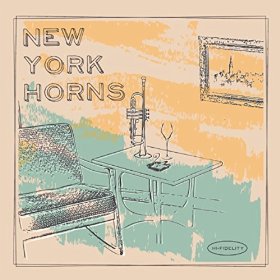 You never know where the next review’s coming from; could be the inbox, could be the letterbox, could be backstage at a gig. Yeah, it’s the last one. A couple of weeks ago, Glenn Alexander slipped this album into my greasy mitt backstage at The Forum in Kentish Town. Glenn’s the guitar player for Southside Johnny and the Asbury Jukes (amongst other things) and he released this solo album last year produced by the Jukes saxophonist, John Isley. If you’re a Jukes fan and you look at the credits for the album, you’ll recognise most of the names; when you work with world-class musicians in the day job, why not use those guys when you pursue your own vision?
You never know where the next review’s coming from; could be the inbox, could be the letterbox, could be backstage at a gig. Yeah, it’s the last one. A couple of weeks ago, Glenn Alexander slipped this album into my greasy mitt backstage at The Forum in Kentish Town. Glenn’s the guitar player for Southside Johnny and the Asbury Jukes (amongst other things) and he released this solo album last year produced by the Jukes saxophonist, John Isley. If you’re a Jukes fan and you look at the credits for the album, you’ll recognise most of the names; when you work with world-class musicians in the day job, why not use those guys when you pursue your own vision?
I’m not giving you a detailed biography of Glenn Alexander; you can find that anywhere. All I’m saying is that this album proves conclusively that Glenn is a lot more than just an incredibly good guitar player. The album opens with the fairly straightforward boogie of “If Your Phone Don’t Ring”; it’s great fun, the horns are every bit as good as you expect the New York Horns to be and it’s a joyous start to the show. Without reading the sleeve notes, it’s obvious that the second song “Earl Erastus” is deeply personal for Glenn. It hints at Jerry Reed’s “Amos Moses” and it’s a tribute to Glenn’s granddad, who raised six kids during the Depression; it has huge emotional power and a lovely New Orleans horn coda of his favourite hymn (I’m guessing) featuring a vocal from Oria Aspen.
From there on in, it’s a melting-pot of the influences flowing over a teenager growing up in the centre of the USA; there’s the funky soul and Elvis-referencing “Memphis Soul”, the country feel of “I Picked the Wrong Day (To Stop Drinkin’)”, the horn-fired shuffle of “Get A Life” (featuring Southside on harmonica) and the slow blues of “Blues For Me & You”, a duet with Oria Aspen contrasting Glenn’s rough-hewn blues vocal with Oria’s more pure jazz stylings.
You might think that was enough, but there are still surprises to come. The album’s penultimate song, “The Odds Are Good”, proves that Glenn Alexander’s not just about melody and guitar solos; the lyrics are clever, and in the style of Dylan or early Springsteen. This guy is much more than a great rock guitarist, he’s a very gifted songwriter and a pretty good singer in a Joe Walsh kinda style. There’s no real commercial imperative behind this album, it was created for the sheer joy of making music with stunningly good players. Great songs, Hammond and horns; this is the business, what more do you need?
“Glenn Alexander & Shadowland” is out now on Rainbow’s Revenge Records.
 It’s relatively easy to record an album these days; you can do it at home or maybe in a studio and it won’t cost you the earth. You can organise your own distribution online or at live shows; you won’t get rich but you will get some return for your creativity. Not everything released by this route is good; there are way too many vanity projects, but occasionally something really worthwhile emerges. Sometimes a group of talented and like-minded musicians get together and just play the tunes they really want to play. If it makes a few dollars, that’s fine, but that’s not really the point because the musicians are playing the music they want to play and having a bit of fun with their own original material and a few covers. Very, very occasionally the result is an album packed with, superb performances and arrangements that you want to listen to again and again. “New York Horns” is one of those.
It’s relatively easy to record an album these days; you can do it at home or maybe in a studio and it won’t cost you the earth. You can organise your own distribution online or at live shows; you won’t get rich but you will get some return for your creativity. Not everything released by this route is good; there are way too many vanity projects, but occasionally something really worthwhile emerges. Sometimes a group of talented and like-minded musicians get together and just play the tunes they really want to play. If it makes a few dollars, that’s fine, but that’s not really the point because the musicians are playing the music they want to play and having a bit of fun with their own original material and a few covers. Very, very occasionally the result is an album packed with, superb performances and arrangements that you want to listen to again and again. “New York Horns” is one of those.
So, who are the New York Horns? Well the horn players are Chris Anderson (trumpet and flugelhorn), John Isley (tenor and baritone sax and bass clarinet) and Neal Pawley (trombone and vocals) and they’re better known as the horn section of Southside Johnny the Asbury Jukes. Here they’re aided and abetted by fellow-Jukes Jeff Kazee (piano, Hammond B3, keys and vocals) and Glenn Alexander(guitars, dobro, mandolin and vocals) and a rhythm section of Shawn Pelton (drums and percussion) and Tony Tino (electric bass).
The album opens with a very different instrumental take on KT Tunstall’s breakthrough song “Black Horse & the Cherry Tree”. Where the original builds gradually by using a loop pedal for instrumental and vocal parts, the NYH version comes in, after a quick guitar intro, at full strength with Latin American percussion (courtesy of Marc Quinones) and perhaps a hint of early Santana. Chris Anderson’s tone poem “Morningside at Midnight” is next, taken at a walking tempo, and evoking the spirit of Morningside Heights with electric piano, wah-wah guitar and unison sax and trumpet. The Hank Williams classic “Hey Good Lookin’” is the first vocal piece, driven along by a guitar riff and horn fills before the sax, guitar and Hammond solos kick in. “Song for Levon”, a Chris Anderson and John isley co-write is a tribute to Levon Helm. It’s stately and mournful in classic New Orleans tradition and features Southside Johnny as guest harmonica player.
The uptempo jazz-funk of John Isley’s “Little Miss Thing” wouldn’t sound out of place on either of Donald Fagen’s first two solo albums and features the first trombone solo on the album from Neal Pawley; it’s great fun. “Can’t Stand to See You Cry”, written and sung by Jeff Kazee, is a powerful soul song with a superb plaintive vocal and an arrangement that Allen Toussaint would be proud of while “Strollin’ With Sean” is a fairly straightforward blues driven along by a horn riff and it’s another chance for the guys to solo for all they’re worth and have a great time. The final cover on the album is John Hiatt’s “Little Head” which retains the feel of the original while adding punch with horn fills.
John Isley’s “78 Below” opens with an uptempo Nile Rodgers –style lead/rhythm riff which, with the punchy bass, drives the piece along underneath a staccato muted trumpet melody before the mood mellows again with Chris Anderson’s “More Than Tears”. Opening with a restrained combination of piano, acoustic guitar and mandolin, this moody and melancholic piece is perfect for the flugelhorn which Chris uses to carry the main melody. John Isley’s “Under the Hood” is an atmospheric piece using Hammond and the horn ensemble to create the mood and features a muted trumpet solo from Chris Anderson. The album’s closing song, “Nothing Left to Say”, opens slowly in New Orleans jazz funeral style, with a guest vocal by Christine Ohlman before erupting just before the halfway mark into uptempo New Orleans jazz with trumpet and sax counterpoint. There’s also a lyrical message here which underpins the whole album; however bad things get, there’s always music to pull you back, whether you play it or listen to it. It’s a perfect way to close the album.
The beauty of this album is that it was made because the musicians involved really wanted to make it. They had a lot of ideas and they wanted to get those ideas out there to people who might want to hear them. It’s not about focus groups or marketing teams; it’s about strong, sometimes very personal, material arranged well and played superbly. If you need to label it, I suppose it’s jazz, but it also pushes out in other directions as well, towards funk and old school soul; there’s certainly plenty of variety on display. Check out some of the song links here and think seriously about buying yourself a copy, if only to let a bunch of great musicians know that some people out there are actually getting the message.
Available now from Amazon and iTunes.


